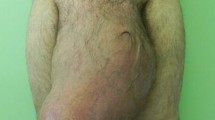Abstract
Purpose
Single scrotal incision for repair of bilateral inguinal hernias in boys is a new and attractive approach. However, the advantages and drawbacks of this approach have not been fully discussed in the literature and it has not been widely accepted as a standard procedure for repair of bilateral inguinal hernias. We develop the median raphe approach and this study is aimed to clarify the outcomes of this new technique.
Methods
From January 2006 to December 2010, we studied 114 boys with bilateral inguinal hernias who underwent trans-scrotal repairs using median raphe incisions. The follow-up durations ranged from 12 to 36 months. The operation time and morbidity of this approach were compared to those of 91 boys who underwent conventional bilateral inguinal incision herniorrhaphy from January 2001 to December 2005.
Results
The operation times were equal in both approaches. The incidence of stitch abscesses was a little higher in scrotal incision group. All the boys with the scrotal approach had excellent cosmetic results.
Conclusion
The median raphe approach for bilateral inguinal hernia repair is a good alternative to the conventional method for boys.


Similar content being viewed by others
References
Bianchi A, Squire BR (1989) Transscrotal orchidopexy: orchidopexy revised. Pediatr Surg Int 4:189–192
Iyer KR, Kumar V, Bianchi A et al (1995) The scrotal approach. Pediatr Surg Int 10:58–60
Koyle MA, Walsh R, Caruso A et al (1999) Scrotal (Bianchi) approach to patent processus vaginalis in children. Tech Urol 5(2):95–99
Fearne C, Abela M, Aquilina D (2002) Scrotal approach for inguinal hernia and hydrocele repair in boys. Eur J Pediatr Surg 12(2):116–117
Lais A, Ferro F (1996) Trans-scrotal approach for surgical correction of cryptorchidism and congenital anomalies of the processus vaginalis. Eur Urol 29(2):235–238 discussion 238–239
Bassel TS, Scherz HC, Kirsch AJ (2007) Scrotal incision orchiopexy for undescended testes with or without a patent processus vaginalis. J Urol 177(4):1516–1518
Parsons JK, Ferrer F, Docimo SG (2003) The low scrotal approach to the ectopic or ascended testicle: prevalence of a patent processus vaginalis. J Urol 169(5):1832–1833 (discussion 1833)
Rajimwale A, Brant WO, Koyle MA (2004) High scrotal (Bianchi) single-incision orchidopexy: a “tailored” approach to the palpable undescended testis. Pediatr Surg Int 20(8):618–622
Calkins CM, St Peter SD, Balcom A et al (2007) Late abscess formation following indirect hernia repair utilizing silk suture. Pediatr Surg Int 23(4):349–352
Author information
Authors and Affiliations
Corresponding author
Rights and permissions
About this article
Cite this article
Shih, TY., Uen, YH. Single scrotal incision for repair of bilateral inguinal hernias in boys. Pediatr Surg Int 28, 417–420 (2012). https://doi.org/10.1007/s00383-011-3049-3
Accepted:
Published:
Issue Date:
DOI: https://doi.org/10.1007/s00383-011-3049-3




